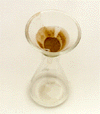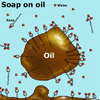From muddy water and milk to toothpaste and soapy water, colloids, suspensions and emulsions play a very important part in our daily lives. All three are different from solutions in that they are heterogeneous mixtures not homogeneous, as in a solution. Being heterogeneous they have two states of matter mixed together. For example milk is a mixture of water and fats.

 Colloids,
suspensions and emulsions are usually easy to detect, as light is scattered
by the large suspended particles. Most solutions will allow light to pass
through unscattered.
Colloids,
suspensions and emulsions are usually easy to detect, as light is scattered
by the large suspended particles. Most solutions will allow light to pass
through unscattered.
This topic explains the three terms and the properties of colloids,
suspensions and emulsions.
 Suspensions
Suspensions
Suspensions are heterogeneous mixtures from which some of the particles
settle with time. Muddy water is a classic suspension, with relatively
large solid particles suspended in water. Upon standing the solids start
to settle to the bottom of the container. In water suspensions the average
suspended particle is larger than 100nm, whereas in a solution all particles
are less than 1nm. Suspensions are usually quite easy to separate into
their components by filtration, with the larger particles being caught
in the filter paper.
Colloids
Colloids are heterogeneous mixtures which do not settle out like suspensions,
but are not true solutions either. Modern plastic paint is a typical colloid,
with plastic particles less than 100nm but bigger than 1nm. These intermediate
sized particles are big enough to scatter light, but small enough to remain
suspended in the liquid. Aerosols, glues, jelly, and smoke are all colloids.
Colloids generally cannot be filtered and do not settle with time. Dust
scattering light from a projector is an example of a solid/gas colloid,
albeit very dilute!
Emulsions
Emulsions are immiscible (incapable of mixing) colloidal suspensions of
one liquid in another liquid. Emulsions will separate into their individual
components if allowed to sit for long enough. Some examples of emulsions
include: face creams, soapy water and salad dressings made by shaken oil
and vinegar.
 Emulsifying agents are required to keep an emulsion stable or unseparated.
Oil and water in "White oil", used to kill aphids on roses,
soon separates after being used. If a detergent is added, the oil and
water no longer separate. This is because the detergent acts as an emulsifying
agent. Its molecules have two very different ends, one soluble in the
oil and the other in the water, thus providing a bridge between the two.
Emulsifying agents are required to keep an emulsion stable or unseparated.
Oil and water in "White oil", used to kill aphids on roses,
soon separates after being used. If a detergent is added, the oil and
water no longer separate. This is because the detergent acts as an emulsifying
agent. Its molecules have two very different ends, one soluble in the
oil and the other in the water, thus providing a bridge between the two.
| Copyright owned by the State of Victoria (Department of Education and Early Childhood Development). Used with Permission. |
|
|||||||||||||||||||||||||||||||||||||||||||||||||||||||||||||||||||||||||||||||||||||